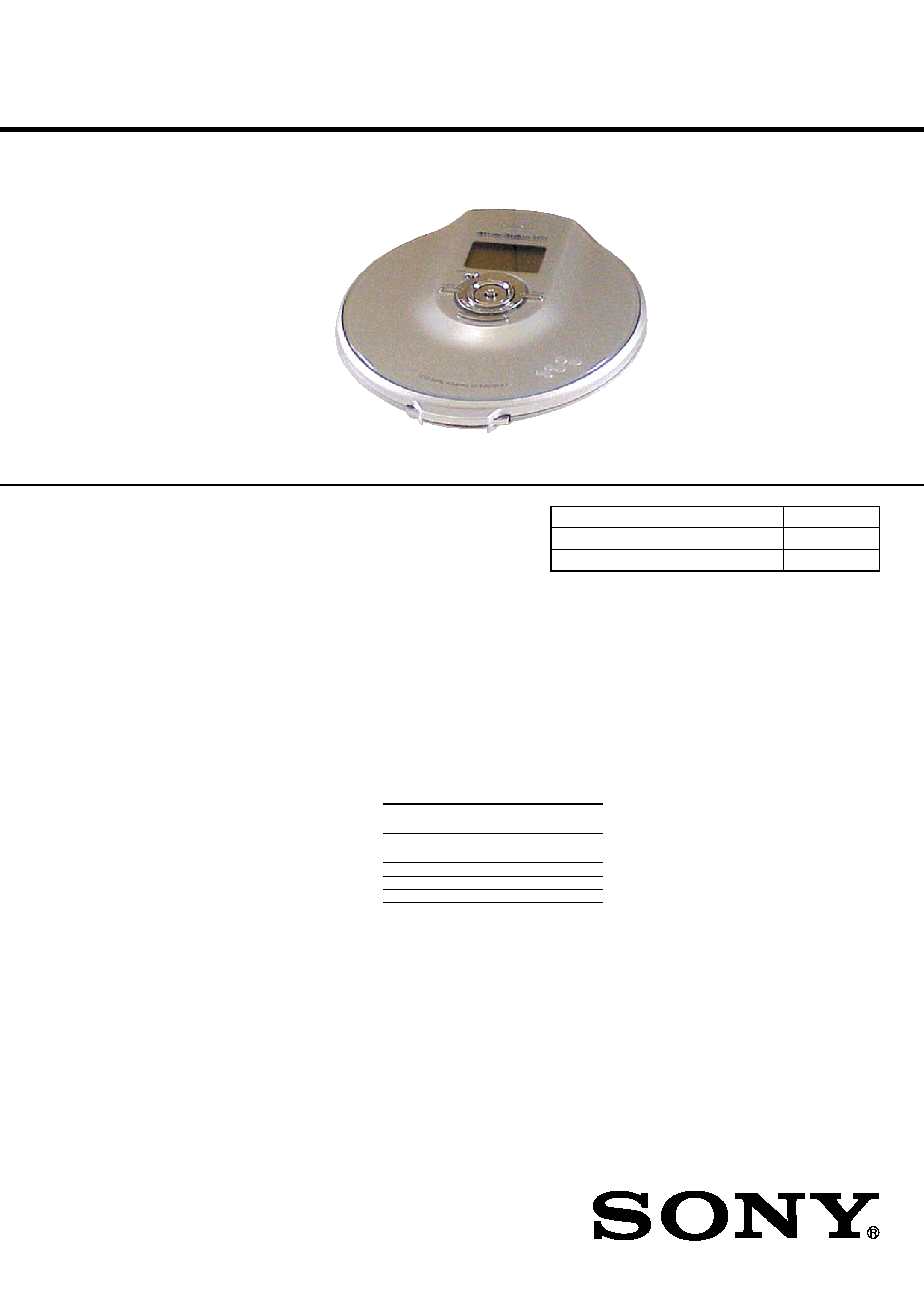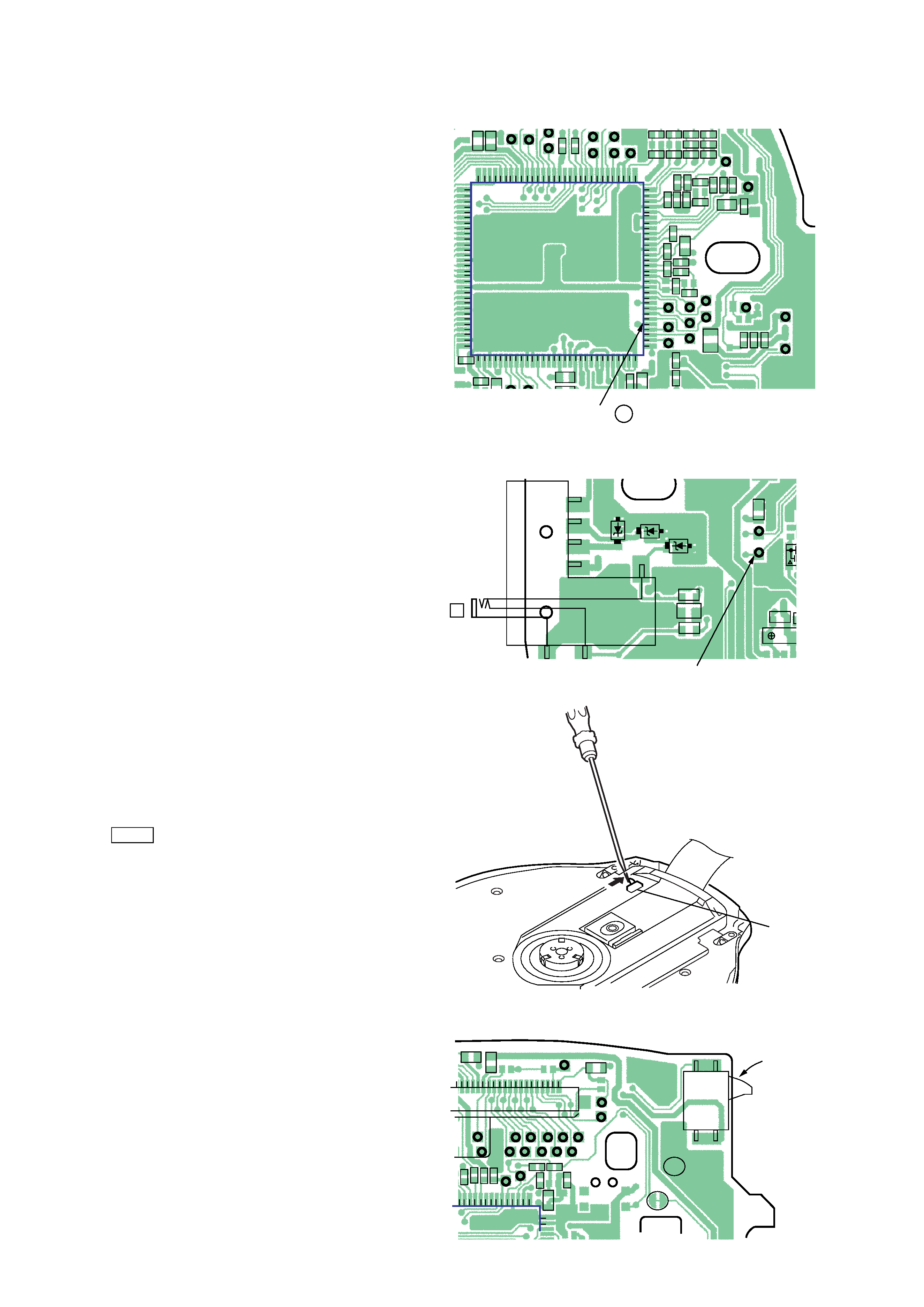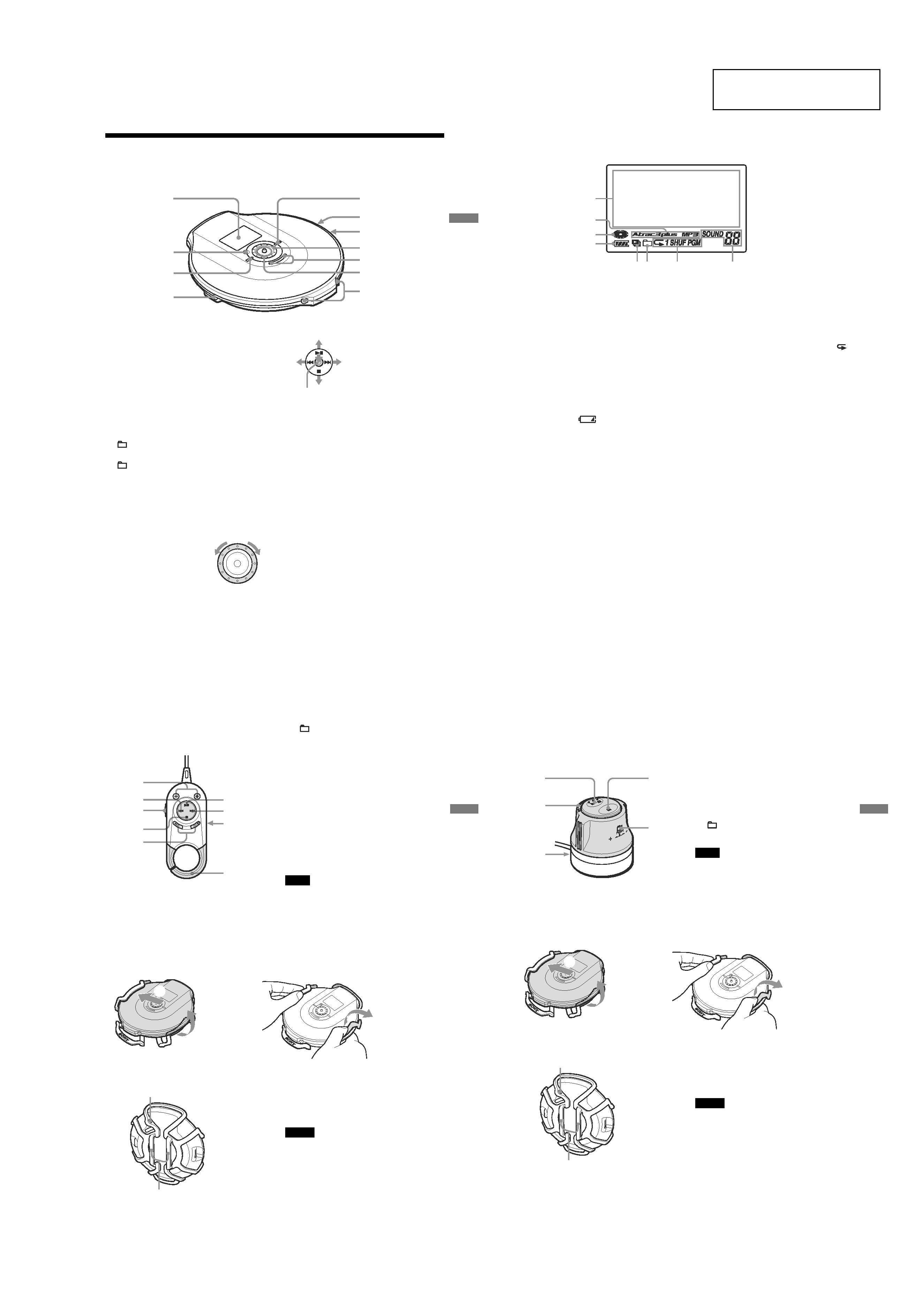
1
Model Name Using Similar Mechanism
D-NE509
CD Mechanism Type
CDM-3325ER2
Optical Pick-up Name
DAX-25E
SERVICE MANUAL
US Model
Canadian Model
D-NE500/NE506CK
E Model
D-NE500
D-NE500/NE506CK
PORTABLE CD PLAYER
CD player
System
Compact disc digital audio system
Laser diode properties
Material: GaAlAs
Wavelength:
= 770 - 800 nm
Emission duration: Continuous
Laser output: Less than 44.6
µW
(This output is the value measured at a distance
of 200 mm from the objective lens surface on
the optical pick-up block with 7 mm aperture.)
D-A conversion
1-bit quartz time-axis control
Frequency response
20 - 20 000 Hz
dB (measured by JEITA)
Output (at 3 V input level)
Headphones (stereo minijack)
Approx. 5 mW + Approx. 5 mW at 16
SPECIFICATIONS
General
Power requirements
· LR6 (size AA) battery: 1.5 V DC
× 1
·AC power adaptor (DC IN 3 V jack):
120 V, 60 Hz
Battery life*1 (approx. hours)
When you use the CD player on a flat and stable
surface.
When LIGHT mode and SOUND mode are set to
"OFF."
Playing time varies depending on how the CD
player is used.
US, CND model:
When using one Sony alkaline battery LR6
(SG) (produced in Japan)
G-PROTECTION
"G-PRO 1"
"G-PRO 2"
Audio CD
33
28
ATRAC CD*2
60
60
MP3 CD*3
45
45
*1 Measured value by the standard of JEITA
(Japan Electronics and Information Technology
Industries Association)
*2 Recorded at 48 kbps
*3 Recorded at 128 kbps
Operating temperature
5
°C - 35°C (41°F - 95°F)
Dimensions (w/h/d) (excluding projecting
parts and controls)
Approx. 129
× 27.5 × 140.1 mm
(5 1 /8
× 1 1 /8 × 5 5 /8 in.)
Mass (excluding accessories)
Approx. 188 g (6.7 oz.)
Supplied accessories
AC power adaptor (1) (for except D-NE500:
US, except D-NE506CK: CND)
Remote control (1)
Rotary commander (1) (for D-NE506CK)
Car battery cord (1) (for D-NE506CK)
Car connecting pack (1) (for D-NE506CK)
Carrying case (1)
CD-ROM (SonicStage Ver. 2.0) (1)
User's guide for SonicStage Ver. 2.0 (1)
Headphones (1) (for US model)
Earphones (1) (for other models)
US and foreign patents licensed from Dolby
Laboratories.
Design and specifications are subject to change
without notice.
·Abbreviation
CND : Canadian model
E92 : AC 120V area in E model
MX : Mexican model
Ver. 1.2 2005.06
9-877-555-03
2005F04-1
© 2005.06
Sony Corporation
Personal Audio Group
Published by Sony Engineering Corporation
+1
2
Photo: D-NE500

2
Flexible Circuit Board Repairing
· Keep the temperature of the soldering iron around 270°C during
repairing.
· Do not touch the soldering iron on the same conductor of the
circuit board (within 3 times).
· Be careful not to apply force on the conductor when soldering
or unsoldering.
Notes on Chip Component Replacement
· Never reuse a disconnected chip component.
· Notice that the minus side of a tantalum capacitor may be
damaged by heat.
D-NE500/NE506CK
SAFETY-RELATED COMPONENT WARNING!!
COMPONENTS IDENTIFIED BY MARK 0 OR DOTTED LINE
WITH MARK 0 ON THE SCHEMATIC DIAGRAMS AND IN
THE PARTS LIST ARE CRITICAL TO SAFE OPERATION.
REPLACE THESE COMPONENTS WITH SONY PARTS WHOSE
PART NUMBERS APPEAR AS SHOWN IN THIS MANUAL OR
IN SUPPLEMENTS PUBLISHED BY SONY.
z
UNLEADED SOLDER
Boards requiring use of unleaded solder are printed with the lead
free mark (LF) indicating the solder contains no lead.
(Caution: Some printed circuit boards may not come printed with
the lead free mark due to their particular size.)
: LEAD FREE MARK
Unleaded solder has the following characteristics.
· Unleaded solder melts at a temperature about 40°C higher than
ordinary solder.
Ordinary soldering irons can be used but the iron tip has to be
applied to the solder joint for a slightly longer time.
Soldering irons using a temperature regulator should be set to
about 350°C.
Caution: The printed pattern (copper foil) may peel away if the
heated tip is applied for too long, so be careful!
· Strong viscosity
Unleaded solder is more viscous (sticky, less prone to flow)
than ordinary solder so use caution not to let solder bridges
occur such as on IC pins, etc.
· Usable with ordinary solder
It is best to use only unleaded solder but unleaded solder may
also be added to ordinary solder.
Notes on the power source
Disconnect all power sources when the CD player is not used for a
long time.
On AC power adaptor
· Use only the AC power adaptor supplied.
If your CD player is not supplied with the one, use the AC-E30HG
AC power adaptor. Do not use any other AC power adaptor. It
may cause a malfunction.
Polarity of the plug
· Do not touch the AC power adaptor with wet hands.
· Connect the AC power adaptor to an easily accessible AC outlet.
Should you notice an abnormality in the AC power adaptor,
disconnect it from the AC outlet immediately.
ATTENTION AU COMPOSANT AYANT RAPPORT
À LA SÉCURITÉ!!
LES COMPOSANTS IDENTIFIÉS PAR UNE MARQUE 0 SUR LES
DIAGRAMMES SCHÉMATIQUES ET LA LISTE DES PIÈCES
SONT CRITIQUES POUR LA SÉCURITÉ DE FONCTIONNEMENT.
NE REMPLACER CES COMPOSANTS QUE PAR DES PIÈCES
SONY DONT LES NUMÉROS SONT DONNÉS DANS CE MANUEL
OU DANS LES SUPPLÉMENTS PUBLIÉS PAR SONY.

3
TABLE OF CONTENTS
1. SERVICE NOTE ................................................................. 4
2. GENERAL
Locating the controls ............................................................... 5
3. DISASSEMBLY
3-1. Upper Lid Assy ................................................................... 7
3-2. Cabinet (Middle) Assy ........................................................ 7
3-3. Main Board, MD Assy ........................................................ 8
3-4. Sled Motor Assy (M602), Optical Pick-up (DAX-25E),
Turntable Motor Assy (M601) ............................................. 8
4. ELECTRICAL ADJUSTMENTS
CD Section .............................................................................. 9
5. DIAGRAMS
5-1. IC Pin Descriptions ........................................................... 10
5-2. Note for Printed Wiring Boards
and Schematic Diagrams .................................................. 15
5-3. Waveforms ......................................................................... 15
5-4. Block Diagram CD Section ........................................... 16
5-5. Block Diagram Power Supply Section .......................... 17
5-6. Printed Wiring Board Main Section .............................. 18
5-7. Schematic Diagram Main Section (1/2) ......................... 20
5-8. Schematic Diagram Main Section (2/2) ......................... 21
5-9. Printed Wiring Board Switch Section ........................... 22
5-10. Schematic Diagram Switch Section ............................... 23
5-11. IC Block Diagrams ............................................................ 24
6. EXPLODED VIEWS
6-1. Upper Lid Section ............................................................. 25
6-2. Cabinet (Lower) Section ................................................... 26
6-3. CD Mechanism Deck Section (CDM-3325ER2) .............. 27
7. ELECTRICAL PARTS LIST ......................................... 28
D-NE500/NE506CK

4
D-NE500/NE506CK
SECTION 1
SERVICE NOTE
NOTES ON HANDLING THE OPTICAL PICK-UP BLOCK
OR BASE UNIT
The laser diode in the optical pick-up block may suffer electro-
static breakdown because of the potential difference generated by
the charged electrostatic load, etc. on clothing and the human body.
During repair, pay attention to electrostatic breakdown and also
use the procedure in the printed matter which is included in the
repair parts.
The flexible board is easily damaged and should be handled with
care.
Precautions for Checking Emission of Laser Diode
Laser light of the equipment is focused by the object lens in the
optical pick-up so that the light focuses on the reflection surface
of the disc. Therefore, be sure to keep your eyes more then 30 cm
apart from the object lens when you check the emission of laser
diode.
Before Replacing the Optical Pick-Up Block
Please be sure to check throughly the parameters as par the "Opti-
cal Pick-Up Block Checking Procedures" (Part No.: 9-960-027-
11) issued separately before replacing the optical pick-up block.
Note and specifications required to check are given below.
· FOK output : IC601 yg pin (or TP624 (FOK))
When checking FOK, remove the lead wire to disc motor.
· RF signal P-to-P value : 0.45 ± 0.1 Vp-p
· The repairing grating holder is impossible.
Laser Diode Checking Methods
During normal operation of the equipment, emission of the laser
diode is prohibited unless the upper lid is closed while turning ON
the S803. (push switch type)
The following two checking methods for the laser diode are
operable.
· Method:
Emission of the laser diode is visually checked.
1. Open the upper lid.
2. With a disc not set, turn on the S803 with a screwdriver having a
thin tip.
Note: Do not push the detection lever strongly, or it may be bent
or damaged.
3. Press the N X button.
4. Observing the objective lens, check that the laser diode emits
light.
When the laser diode does not emit light, automatic power
control circuit or optical pick-up is faulty.
In this operation, the objective lens will move up and down 5
times along with inward motion for the focus search.
TP644
RP642
TP640
TP639
TP636
TP635
TP633
TP632
TP631
TP610
TP701
R641
C608
C603
R608
R611
C616
C604
R620
R610
C615
R606
R618
C614
R605
R616
C613
R631
TP648 TP646
FB603
FB602
FB301
C610
C623
FB606
C609
VDR603
C625
R613
R103
TP627
TP623
TP621
TP622
TP626
TP630
R203
R315
R630
R314
C311
R625
R614
R603
R602
R609
C611
R615
R612
C605
R604
R624
R623
C621
R628
61
90
91
30
120
IC601
1
60
31
TP301
TP629
TP625
TP302
TP102
IC601 65 pin
MAIN BOARD (SIDE B)
C617
FB101
TP628
TP624
FB303
FB201
VDR602 VDR609
X601
C612
D306
D101
D305
J301
J301
i
TP624
MAIN BOARD (SIDE A)
S803
TP823
TP822
TP833
TP842
TP835
TP846
TP806
TP829
TP825
TP831
TP827
TP824
R834 R832
25
24
26
R827
R828
R829
R303
TP834
TP832
TP830
TP828
TP826
R842
R847
VDR802
VDR804
SL806
CN802
R840
C812
S803
(OPEN/CLOSE)
S803
MAIN BOARD (SIDE B)

5
D-NE500/NE506CK
SECTION 2
GENERAL
This section is extracted
from instruction manual.
11
1
5
6
7
8
9
q;
qa
2
3
4
Locating the controls
CD player
For details, see the pages in parentheses.
Getting
started
(Continued)
1
Display (12, 16, 18, 19, 21 - 23, 33, 34)
2
OPR (operation) lamp (25, 26)
Color of the lamp changes according to
the type of music source being played.
Red: Audio CD, Green: ATRAC3plus/
ATRAC3 file, Orange: MP3 file
For some time after the CD is inserted,
the lamp lights up in red, orange and
green in turn.
This lamp also functions as the HOLD
lamp.
3
(group) button (15, 21 - 23, 25, 33)
4
i (headphones) jack (14)
5
(group) + button (15, 21, 22)
6
HOLD switch (rear) (25)
Slide the switch in the direction of the
arrow to disable the buttons on the CD
player.
7
DC IN 3 V (external power input) jack
(14)
8
Jog dial (18 - 27, 33)
Use to select a file, play
mode, etc. The search
direction changes
according to the direction
in which the jog dial is turned.
9
VOL (volume) +*1/ buttons (15)
q;
5-way control key (15, 16, 18 - 27, 33)
u: play/pause
.:AMS*2/rewind
>: AMS/fast forward
x: stop
DISPLAY/MENU: Use to
select menu items and enter
the selection.
Push the control key toward u, .,
> or x with your finger on
DISPLAY/MENU.
qa
OPEN switch (14, 31)
Squeeze the switch from both sides.
*1 The button has a tactile dot.
*2 Automatic Music Sensor
DISPLAY/
MENU
12
Display
For details, see the pages in parentheses.
1
2
3
4
56
7
8
1
Character information display (16)
While playing an audio CD, disc name,
track name, etc. appear in 4 lines, if
recorded on the CD.
While playing an ATRAC CD/MP3 CD,
group name, file name, etc. appear in 4
lines, if recorded on the CD.
Menu items also appear in this display.
2
Atrac3plus/MP3 indication
3
Disc indication
Lights up while the CD player is playing.
4
Battery indication (31)
Roughly shows the remaining power of
the battery. If "
" flashes, the battery
is depleted.
5
Play list indication
For MP3 CD only
6
Group indication
For ATRAC CD/MP3 CD only
7
Play mode indication
Shows various play modes such as single
play, shuffle play and program play. "
"
shows repeat play.
8
SOUND indication
Shows the SOUND setting which has
been selected on the menu.
13
3
2
1
4
5
7
8
6
9
Remote control
For details, see the pages in parentheses.
Getting
started
1
( group) /+ buttons (15)
2
. (AMS/rewind) button (15)
3
HOLD switch (25)
Slide the switch in the direction of the
arrow to disable the buttons on the
remote control.
4
x (stop) button (15)
5
VOL (volume) +/ buttons (15)
6
u (play/pause) button (15)
7
> (AMS/fast forward) button (15)
8
Headphone jack (rear)
9
Hook
Use to hang the remote control on a
knapsack, etc.
Note
Use only the supplied remote control. You cannot
operate this CD player with the remote control
supplied with other CD players.
Using the carrying case
To attach the case
To remove the case
2
1
You can pass your strap or belt through the case.
Strap hole
Belt loop
Notes
· The carrying case is not designed to protect the
CD player.
· When attaching and removing the case,
disconnect the AC power adaptor and the remote
control first.
13
Getting
started
Using the carrying case
To attach the case
To remove the case
2
1
You can pass your strap or belt through the case.
Strap hole
Belt loop
Notes
· The carrying case is not designed to protect the
CD player.
· When attaching and removing the case,
disconnect the AC power adaptor and the remote
control first.
Rotary commander
For details, see the pages in parentheses.
1
u (play/pause) button (15)
2
.(AMS/search)·> (AMS/search)
control (15)
3
Jack for connecting a car connecting pack
(28)
4
x (stop) button (15)
5
( group) +/ control (15)
Push down and turn.
Note
The supplied rotary commander should be used
with this player only.
1
2
3
4
5
· D-NE506CK
